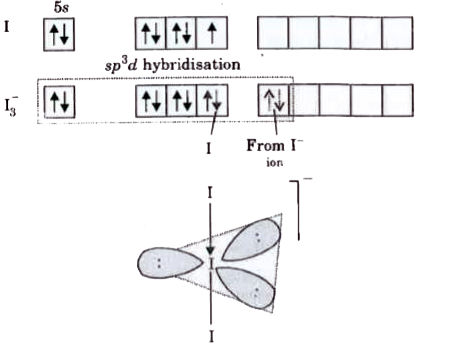The geometry of I−3 is
The central I atom has the ground state electronic configuration as 5s25p5. It involves sp3d hybridization involving one 5s, three 5p and one vacant 5d orbital. The half filled sp3d hybrid orbital forms a covalent bond with one I atom and an empty sp3d hybrid orbital accepts an electron pair from I− ion to form a coordinate bond. Thus, the geometry of the molecule is trigonal bipyramidal in which three positions are occupied by lone pairs.

Because of the equivalent positions of lone pairs the resulting I−3 ion is linear.
Topper's Solved these Questions
- BOOK - MODERN PUBLICATIONCHAPTER - CHEMICAL BONDING AND MOLECULAR STRUCTUREEXERCISE - OBJECTIVE TYPE QUESTIONS (A. MULTIPLE CHOICE QUESTIONS)35videos
CHEMICAL BONDING AND MOLECULAR STRUCTURE
- BOOK - MODERN PUBLICATIONCHAPTER - CHEMICAL BONDING AND MOLECULAR STRUCTUREEXERCISE - OBJECTIVE TYPE QUESTIONS (B. MULTIPLE CHOICE QUESTIONS)40videos
CHEMICAL BONDING AND MOLECULAR STRUCTURE
- BOOK - MODERN PUBLICATIONCHAPTER - CHEMICAL BONDING AND MOLECULAR STRUCTUREEXERCISE - Revision Exercises (Objective Questions)(Long Answer Questions)12videos
CHEMICAL BONDING AND MOLECULAR STRUCTURE
- BOOK - MODERN PUBLICATIONCHAPTER - CLASSIFICATION OF ELEMENTS AND PERIODICITY IN PROPERTIES EXERCISE - UNIT PRACTICE TEST13videos
CLASSIFICATION OF ELEMENTS AND PERIODICITY IN PROPERTIES
Similar Questions
Knowledge Check
- Question 1 - Select One
The geometry of XeF+3 is
ASee-SawBT-shapeCTriangular planarDPyramidal - Question 2 - Select One
According to the VSEPR theory the geometry of ClO−3 ion should be
APlanar trianglularBTrigonal pyramidalCTetrahedralDSquare planar - Question 3 - Select One
The geometry of [NiCl4]2− and [NiCl2(Pme3)2] are :
Aboth square planarBtetrahedral and square planar respectivelyCboth tetrahedralDsquare planar and tetrahedral respectively
The geometry of sp3d2 hybrid orbitals is
View SolutionWhat is the geometry of BrF3?
View SolutionThe geometry of XeOF2 is
View SolutionHybridization is a concept of mixing or merging of orbitals of same atom with slight differences in energies to redistribute their energies and give new orbitals of equivalent energy called 'Hybrid Orbitals'. Hybridisation is a hypothetical concept and never actually exists.
One should not be confused by a common misconception that hybridization is responsible for particular geometry. Geometry of a molecule is decided by energy factor not by hybridization. It is the orbital (which may be half filled, completely filled or empty) that undergoes hybridization and not the electron. The bond angles in hybridised orbitals are influenced by presence of lone pair, presence of multiple bonds, presence of one electron and electronegativity of atom.
An increase in s-character of hybridised orbitals results in decrease in size of orbitals. This results in decrease in bond length and increase in energy.
Among the following which have the same molecular geometry?
(P) I−3
(Q) XeF4
(R) BrF−4
(S) XeO2F2View SolutionThe geometry of [Ag(NH3)2]+ ion is
View Solution

